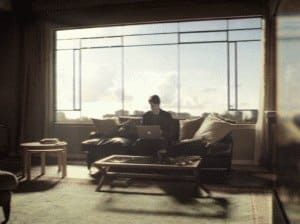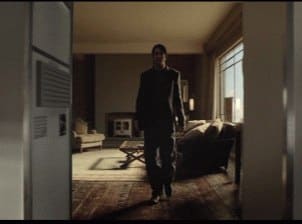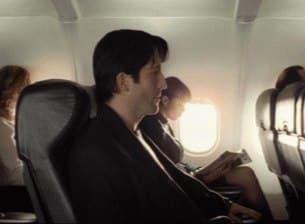British Airways Shoot for “Knucklehead”
British Airways Shoot for “Knucklehead”
The latest BA commercial, directed by award winner Daniel Barber from Knucklehead , used extensive motion control techniques supplied by the Visual Effects Company based in London.
The commercial begins outside the window of a flat looking at a man inside. With the hero character staying centre frame, the camera travels in a perfect arc through the wall continuing into a living room where the man is sitting on a sofa using a laptop computer. We pass a fish tank and, as the camera comes to rest, we follow the man who stands up and walks towards the camera and through a doorway before taking a seat in an aeroplane cabin. Still focused on the man, the camera continues tracking backwards through the cabin and out through the fuselage and tail of the plane.
The VFX Co were involved in the project from the very start which allowed all the technical aspects to be foreseen and resolved before the shoot. Malcolm Wooldridge, senior motion control cameraman at the VFX Co, oversaw the project “The whole sequence had been planned in detail using pre-visualisation. 3D Data and dimensions from this pre-vis were then used to allow the set to be constructed and positioned in the studio to allow the motion control camera access to the required areas with the minimum of fuss. It was important to know well in advance which parts of the set needed to ‘float’ and what we would see after we had passed through wall etc so that these could be integrated into the design from the outset. ” he continues “by using our custom ‘rig chase’ software we were able to directly import the pre-vis moves on set and adjust them as necessary to accomplish the shot. The software is a very versatile and useful tool, giving us the ability to accurately predict where the rails should be positioned and which walls needed to be removed.”
The sequence was broken down into 4 main moves from 3 rail positions. The first two shots were programmed using a standard Milo motion control system supplied with an Arri 435 Advanced camera recording the takes. “The transition through the wall from outside to inside was used as a wipe point between the first 2 moves. There was enough overlap to allow for pre and post roll” explains operator Digna Nigoumi. “and an offset pass was also shot for the fascia wall replacement of the outside of the flat. The second move overlapped the first and used a 3D generated fish tank as its end wipe point. For the third and fourth moves, an 8 foot tall rostrum was constructed on which the Milo was placed. The use of our long arm gave us the reach to the overlap position and allowed the rig to pass over the aircraft lockers during the final track back. Some of the sections required very fast rig movements so we were able to ‘vary-speed’ the move where necessary and make sure that we were back to 25Fps at the point that Daniel wanted. Frame count inserters were output from the motion control computer and used to edit the video feed from the camera on set. This enabled us to accurately join each move section together so that Daniel could check the pace and composition of the wipes. As the cabin interior was only about 7 seats deep, replacement passes were also needed to fill in the other missing rows of seats and roof sections”
Effects supervisor Jason Watts and CG artist Andrew Daffy were on set during the shoot to composite the various passes recorded from the video tape and advise accordingly.



